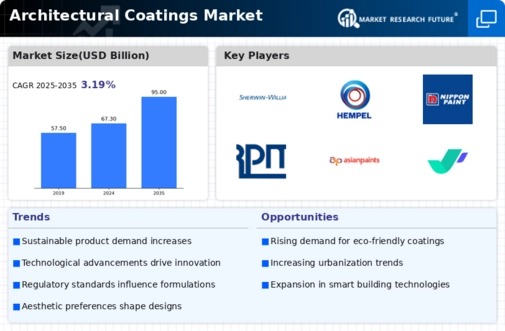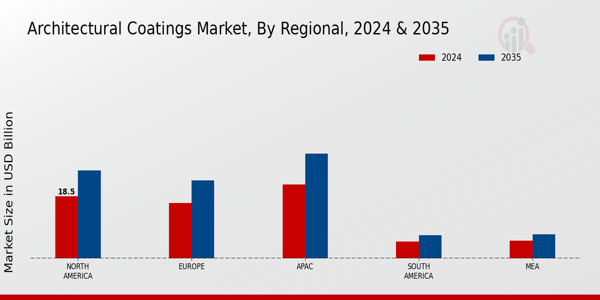Market Growth Projections
The Global Architectural Coatings Market Industry is projected to experience robust growth in the coming years. With a market value of 67.3 USD Billion in 2024, it is anticipated to reach 95 USD Billion by 2035, reflecting a compound annual growth rate (CAGR) of 3.19% from 2025 to 2035. This growth is driven by various factors, including urbanization, technological advancements, and increasing consumer preferences for sustainable products. As the market evolves, it is likely to witness the introduction of innovative coatings that cater to diverse applications, further enhancing its growth potential.
Sustainable Building Practices
The Global Architectural Coatings Market Industry is increasingly influenced by the shift towards sustainable building practices. As environmental concerns gain prominence, architects and builders are opting for eco-friendly coatings that minimize environmental impact. This trend is reflected in the growing demand for low-VOC and water-based coatings, which are perceived as safer alternatives. In 2024, the market is projected to reach 67.3 USD Billion, driven by regulations promoting sustainable construction. This shift not only enhances the appeal of buildings but also aligns with global sustainability goals, indicating a potential for continued growth in the sector.
Government Regulations and Standards
Government regulations and standards play a crucial role in shaping the Global Architectural Coatings Market Industry. Stricter environmental regulations are compelling manufacturers to develop coatings that comply with low emissions and safety standards. These regulations often promote the use of sustainable materials and practices, thereby influencing product formulations. For instance, many countries are implementing stringent VOC limits, which are driving the demand for water-based and low-VOC coatings. As a result, manufacturers are adapting their product lines to meet these requirements, which is expected to contribute to the market's growth trajectory in the coming years.
Rising Consumer Awareness and Preferences
Rising consumer awareness and preferences are significantly impacting the Global Architectural Coatings Market Industry. As consumers become more informed about the benefits of high-quality coatings, there is a growing demand for products that offer enhanced durability, aesthetic appeal, and environmental safety. This shift in consumer behavior is prompting manufacturers to focus on product innovation and marketing strategies that highlight the advantages of their coatings. Additionally, the increasing popularity of home improvement projects is further driving demand, as homeowners seek to enhance the appearance and longevity of their properties. This trend is likely to sustain market growth in the foreseeable future.
Urbanization and Infrastructure Development
Rapid urbanization and infrastructure development are pivotal drivers of the Global Architectural Coatings Market Industry. As populations migrate towards urban centers, the demand for residential and commercial buildings surges. This trend necessitates the use of architectural coatings to protect structures and enhance aesthetic appeal. The United Nations projects that by 2030, nearly 60 percent of the global population will reside in urban areas, further fueling this demand. Consequently, the market is expected to expand significantly, with forecasts suggesting a growth to 95 USD Billion by 2035, highlighting the critical role of coatings in urban development.
Technological Advancements in Coating Formulations
Technological advancements in coating formulations are transforming the Global Architectural Coatings Market Industry. Innovations such as nanotechnology and advanced polymer chemistry are leading to the development of high-performance coatings that offer superior durability and resistance to environmental factors. These advancements not only enhance the longevity of coatings but also improve their application properties, making them more appealing to consumers. As a result, manufacturers are increasingly investing in research and development to create innovative products that meet evolving market demands. This focus on technology is likely to drive market growth, as consumers seek coatings that provide both aesthetic and functional benefits.
















